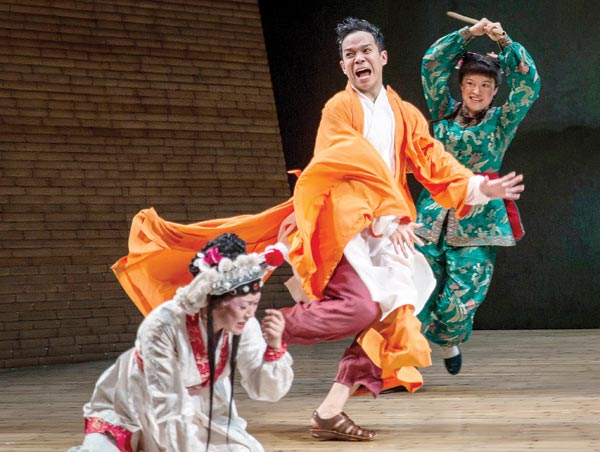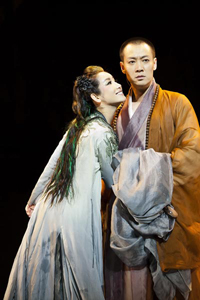|
 |
|
The White Snake has been wowing audiences in the US. PROVIDED TO CHINA DAILY |
Much of the plot in the Chinese folktale about a white snake spirit falling in love with a human takes place in water, including the trans-species encounter in drizzle and a torrential flood being whipped up to rescue the human husband.
|
 |
| Director Tian Qinxin's Green Snake?enjoys overseas success |
In case you're confused, Green Snake is the younger sister of White Snake. She is usually portrayed as more quicksilver and tempestuous and in Tian Qinxin's retelling she is the one who embodies the basic human instinct of sexual desire, or should it be animal instinct?
The venerable theater director, who is a devout Buddhist, added many twists to the familiar yarn: Fa Hai is no longer the evil monk who sets out to break up the forbidden romance. Instead, he is the target of endless rounds of temptation and, with a heart ailment, has to balance what his heart calls for and what religious duty demands of him.
In a touch of programming genius, the festival, which runs from Oct 30 to Nov 9, will end with another adaptation of the Chinese legend — from another woman writer-director, this time from the United States.
Mary Zimmerman's The White Snake has been wowing US audiences since it premiered in early 2012. Now it is coming to the place where the tale unfolded — the bulk of the story allegedly took place just one hour from Wuzhen, in Hangzhou, the capital of Zhejiang.
Zimmerman's account hews much more closely to the version familiar to Chinese than Tian's, but she brings something uniquely her own, or perhaps representative of a US approach to myth interpretation.
Her presentation is full of wit and charm, employing puppetry for the snakes and a stage design that is at once Disney-like and a throwback to the traditional Chinese aesthetic of suggestiveness. The scenes of the lovers' first encounter in the rain and the stealing of the magic herb are illustrative of the wonder of East meets West in theatrical innovation.
Using the theme of "metamorphoses", this edition of the new festival has expanded its lineup of specially invited plays from last year's six to 17, hailing from the Netherlands, India, South Korea and Denmark, as well as more familiar locations.
Theater lovers from across China have found Wuzhen to be a new destination of pilgrimage. As many as 1,500 performances from 300 troupes will grace this ancient water town, popping up at street corners and riverside plazas and presenting a cornucopia of carnival shows to tourists or anyone who happens to saunter by.
Wuzhen is also a platform where young talent has a chance to excel in competition and rub shoulders with masters of the art form like Stan Lai, Lin Zhaohua, Huang Lei and Meng Jinghui.
All of them, plus their international peers like Eugenio Barba and Terry O'Reilly, will appear in a rich variety of forums and workshops where the art of theater — Chinese or Western — will be analyzed and its future contemplated.
"The 11-day event is a conduit through which the West will find the wonders of Chinese theatrical tradition and vice versa," said Stan Lai, a co-founder and artistic director of the festival.
|
|
|
|
|
|
|
|
